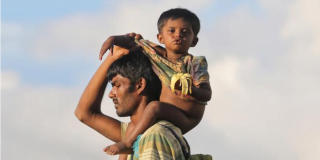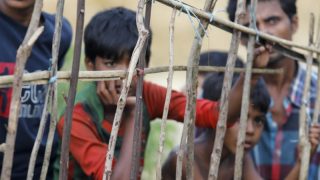The map above shows signatories to the Refugee Convention/Protocol. Countries in gray are not signatories.
So if you were fleeing persecution from Sri Lanka, the tiny island off the coast of India where would you flee? You’ve basically got three nearby options if you want to go somewhere who’ll accept you – Cambodia, Yemen and Australia.
Mmmm, bit of a no-brainer…oh sorry, your choices are now Cambodia and Yemen. Seems the Australians will no longer accept you.







The truly oppressed in Sri Lanka are probably too busy being oppressed and persecuted by the authorities to be able to even think about how they can illegally reach our shores 🙂 Just food for thought. And by the way, I am a Coptic (Egyptian) practicing Christian Migrant who came to Australia in 1987 through legal means, because at least the majority of Australian rhetoric appears to reflect many Christian principals. Due to my work as Migration Agent/Solicitor, I am with the Government and indeed in favor of stopping the boats coming to our shores. In addition, I do not think the Government should stop there. Instead, I believe Australia needs to be pro-active about seeking genuine refugees to come here and build a future for themselves and/or their families. As long as they are GENUINE, I am all for it.
I often wonder what people actually mean by ” Genuine refugee” a person is either an asylum seeker, who may or may not be granted RSD or they are a refugee. Where does the genuine fit in ? How can a person be a ” non genuine refugee ” again I am just wondering!
Andy, just saw this post – sorry I do not check the box to subscribe to notifications for new posts, so I have to read over the page to see if there are replies and in this instance I didn’t see yours until now. “Genuine” are those refugees whose circumstances are real and you may only get to know about it, not through them direct, as they may not have any means of communicating their circumstances to others. Unless someone else communicates it for them – usually people who are local (who out of compassion or other reasons voice the conditions they suffer on their behalf), Human Rights Organisations, journalists who are so inclined (and there aren’t many of them) and/or charity organisations (such as Voice of the Martyrs, who the Australian Government does not want to acknowledge their work and does not recognise any donations going to support them as tax deductible donations). As I stated previously, usually the refugees who make it here leave many question marks in relation t the circumstances they claim they suffer and many unanswered questions. This is mainly due to not disclosing their real identities in many ways (they either do not have papers and we rely on them to give us certain references to check with them the validity of the stories they tell or have papers sealed with the Government seals but there are question marks about how these papers are obtained as many who come from developing countries are used to get whatever they ask for if they pay their Government officials enough monies), nor are they able to substantiate how they afforded the trip all the way over here, in many cases, not just paying for themselves but also for many other family members – whether they were supported by certain organisations? (If so, what were these organisations? What are the organisations rhetoric, agenda, belief system, etc), especially in the event where many of them report that they lived in very poor conditions and/or under very harsh circumstances (including, but not limited to harsh financial circumstances). It then logically follows that they didn’t have enough monies saved to pay the monies required for the trip all the way over here, in some instances not just for themselves but also for other family members (including, but not limited to, paying people smugglers who demand hefty payments). All these question marks and unanswered questions stem from so much ambiguity surrounding 21st Century refugees. Does this answer your question? If not, please let me know and I will attempt to clarify it better for you. Cheers, Me 🙂
As a migration agent and solicitor you would know that seeking asylum is not illegal. And my experience of refugees is that many spend great effort thinking about how to flee and create a new life.
Dear Scott,
Although Australia signed and ratified the UN Refugee Treaty, it did so on the condition that the treaty would only be legally binding in the event that the Treaty terms and conditions are echoed in the Australian Legislation. The Australian legislation does not, to date, echo any of the terms and conditions of the UN Treaty. This renders the Treaty non-legally binding from both National and International perspectives. And, in turn, people who do make it to our shores are indeed illegally coming to our shores as our Legislation forbids them from being on our shores in the first place. Tricky? May be. But from a legal perspective, those who do make it to our shores are illegal. As for those who I believe are genuine refugees who I also believe are trapped in their countries with no legal and/or illegal means of escaping, are, in any case usually kept and tortured in prison. I think the only thing on their mind is seeking God’s strength, wisdom, love and patience to help them through (and may be out of) this indeed horrific situation. Hope I clarified some of the issues for you. God bless.
If as you claim Trojan.All asylum seekers who arrive in Australia are here illegally.this is according to your understanding of the legislation relating to the UN convention. Pleae tell me why in your expert opinion does DIAC grant RSD to nearly all who arrive here by plane and claim asylum and a very large % of those who arrive by boat without a valid visa. If they are all here illegally why doesn’t DIAC reject them all and deport them ? Just wondering.
Hi Andy,
The fact they are illegal means: (1)they have no right to be on our shores – this in turn legally justifies keeping them off-shore until their papers and claims are investigated and/or processed accordingly; and (2) since they are illegal and are NOT Australian Citizens then we do not have a legal duty of care towards them (as opposed to Australian Citizens who may be prisoners but we have a binding legal duty of care towards them regardless of the fact that they have been found to be unlawful). So this means that Australia, by rendering them as unlawful/illegal, are well within their legal rights to keep them off-shore and therefore process their papers as they would process any other off-shore applicants. The legislation also does not put time constraints and/or restrictions in relation to processing their applications. This is the aim of making them illegal and/or unlawful entrants to Australia. Once they are off-shore then they are no longer considered as unlawful entrants (logically of-course as they are off-shore) and can apply as any one else who is considered to be an off-shore applicant and they are processed accordingly. Does this answer your question? I wasn’t sure what your question was aiming for exactly, so I answered it according to my understanding of it and may be not necessarily according to what you wanted to know and/or get at. Hope this helps. Cheers, Me 🙂
What do the countries in yellow mean?
Isn’t it sad that a mega wealthy country like Saudi Arabia does not accept refugees
hi melissa,
the 1951 convention applied only to refugees from post ww2 europe. the 1967 protocol extended it to refugees everywhere. Dark green indicate countries that are signatory to both the Convention and the protocol. yellow indicates they are a signatory t the protocol only.
Scott the way things are going we had better change the colour of Australia from green to grey !!
From the Australian Parliament House Library
Are asylum seekers ‘illegals’?
Generally speaking ‘illegal immigrants’ are people who enter a country without meeting the legal requirements for entry (without a valid visa, for example). However, under Article 14 of the 1948 Universal declaration of human rights, everyone has the right to seek asylum and the 1951 Refugee Convention prohibits states from imposing penalties on those entering ‘illegally’ who come directly from a territory where their life or freedom is threatened.[7]
The UNHCR emphasises that a person who has a well-founded fear of persecution should be viewed as a refugee and not be labelled an ‘illegal immigrant’ as the very nature of persecution means that their only means of escape may be via illegal entry and/or the use of false documentation.[8] The Refugee Council of Australia similarly notes the practical difficulties encountered by asylum seekers in obtaining the requisite documentation prior to departure:
Asylum seekers do not break any Australian laws simply by arriving on boats or without authorisation. Australian and international law make these allowances because it is not always safe or practicable for asylum seekers to obtain travel documents or travel through authorised channels. Refugees are, by definition, persons fleeing persecution and in most cases are being persecuted by their own government. It is often too dangerous for refugees to apply for a passport or exit visa or approach an Australian Embassy for a visa, as such actions could put their lives, and the lives of their families, at risk. Refugees may also be forced to flee with little notice due to rapidly deteriorating situations and do not have time to apply for travel documents or arrange travel through authorised channels. Permitting asylum seekers to entry a country without travel documents is similar to allowing ambulance drivers to exceed the speed limit in an emergency – the action would be ordinarily be considered illegal, but the circumstances warrant an exception.[9]
Asylum seekers irrespective of their mode of arrival, like others that arrive in Australia without a valid visa, are classified by Australian law to be ‘unlawful non-citizens’. However, the term ‘unlawful’ does not mean that asylum seekers have committed a criminal offence. There is no offence under Australian law that criminalises the act of arriving in Australia or the seeking of asylum without a valid visa.[10]
The confusion about legal status arises from those arriving by boat doing so without a valid visa or any other appropriate authorisation, whereas most, though not all, who arrive by air and then seek asylum, usually enter on a valid visa. Currently, when unauthorised boat arrivals are intercepted in Australian waters, the passengers are usually transferred to Christmas Island in order to establish their reasons for attempting to enter Australia without authority. Many are then transferred at a later date to immigration detention centres on the mainland (or immigration detention alternatives such as community based detention).[11] Others may be released into the community on bridging visas while their asylum claims are assessed.[12] However, some may be transferred offshore for processing in Nauru or Papua New Guinea (PNG).[13]
Previously, if a government official determined that an individual was raising claims which may engage Australia’s protection obligations, the asylum seeker was assessed under the Protection Obligations Determination (POD) process in place at the time on Christmas Island.[14] However, on 25 November 2011, the Minister for Immigration and Citizenship announced the end of a parallel refugee status assessment process for boat arrivals and a return to a single protection visa processing system.[15] Subsequently, in March 2012, a single statutory Protection visa process for both boat and air arrivals came into effect. The onshore arrangements for application and independent review through the Refugee Review Tribunal (RRT) system now apply to all people seeking asylum in Australia, regardless of their mode of arrival.[16]
The majority of people arriving unauthorised by boat claim asylum although a few may not (these are usually crew members).[17] The preferred term for boat arrivals as used by the Department of Immigration and Citizenship (DIAC) is ‘irregular maritime arrival’ or IMA and, as noted above, people arriving by such means who then claim asylum are entitled to do so.
The term ‘illegal’ may more appropriately apply to those without a valid visa (‘unlawful non-citizens’) who are not seeking protection, such as visa overstayers.[18] As at 30 June 2011, it was estimated that there were about 58 400 visa overstayers residing in Australia.[19]
Scott, so what does this say in your opinion? How did you interpret this and what do you think it means? Do you have a name for the complete source or a link for this extract? How does it negate my insider insight – on first and quick reading of it, I believe it appears to substantiate many of my statements 🙂 Cheers, Me 🙂